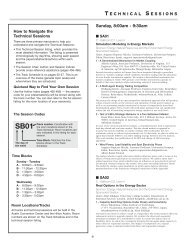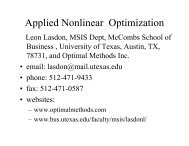[PDF] ALIO Back Matter
[PDF] ALIO Back Matter
[PDF] ALIO Back Matter
You also want an ePaper? Increase the reach of your titles
YUMPU automatically turns print PDFs into web optimized ePapers that Google loves.
SB19<br />
5 - An Application to Improve the Efficiency of a Paced Assembly Line<br />
for Aircrafts<br />
Sue Abdinnour, Professor, Wichita State University,<br />
1845 Fairmont, Barton School of Business, Wichita, KS, 67226,<br />
United States of America, sue.abdinnour@wichita.edu<br />
The application helps managers monitor a large number of tasks that are required to<br />
build an aircraft on a paced assembly line. Task information (time, predecessors,<br />
etc.) is stored in a database. A web interface is designed to work seamlessly with the<br />
database by sending query requests. Similarly, it works with a spreadsheet to run<br />
critical path analysis for a group of tasks at a workstation. The application generates<br />
reports that help manage the assembly line and improve its efficiency.<br />
■ SB19<br />
Aula 383- Third Floor<br />
Public Transport<br />
Cluster: Logistics, Vehicle Routing and Location<br />
Invited Session<br />
Chair: Janny Leung, Professor, Chinese University of Hong Kong,<br />
Dept. of Systems Engineering, Shatin, NT, Hong Kong - PRC,<br />
janny@se.cuhk.edu.hk<br />
1 - On Designing Connected Rapid Transit Networks Reducing the<br />
Number of Transfers<br />
Laureano Escudero, Professor, Universidad Rey Juan Carlos,<br />
Dpto. de Estadística e Invest. Operativa, Madrid, Spain,<br />
laureano.escudero@urjc.es, Susana Muñoz<br />
In this work we deal with a modification of the well-known extended rapid transit<br />
network design problem. On one side, we propose an integer programming model<br />
for selecting the stations to be constructed and the links between them, in such a<br />
way that a connected rapid transit network is obtained. On other side, we present a<br />
greedy heuristic procedure which attempts to minimize an estimation of the total<br />
number of transfers that should be done by the users to arrive at their destinations.<br />
2 - A Math Programming Approach for Selecting Attractive Express<br />
Services on a BRT with Capacity Constraints<br />
Ricardo Giesen, Assistant Professor, Pontificia Universidad Católica<br />
de Chile, Departamento de Ingeniería de Transporte, Vicuna<br />
Mackenna 4860, Macul, Santiago, Chile, giesen@ing.puc.cl,<br />
Homero Larrain, Juan Carlos Munoz<br />
A mathematical programming based method for obtaining the best express services<br />
on a high-demand transit corridor is provided. A solution method for the non-linear<br />
integer formulation is developed. Finally, the model is applied to determine which<br />
scenarios (demand characteristics, operation issues and corridor topology) make<br />
express services more attractive.<br />
3 - Game Theoretic Models for Competition in Public Transit Services<br />
Janny Leung, Professor, Chinese University of Hong Kong,<br />
Dept. of Systems Engineering, Shatin, NT, Hong Kong - PRC,<br />
janny@se.cuhk.edu.hk<br />
As metropolitan areas grow, commuting needs increase the burden on public<br />
transport systems, leading to traffic congestion and pollution. We model the<br />
competitive situation when several service providers offer public transit services<br />
using potential games, and discuss mathematical programmes for finding their Nash<br />
equilibria. We investigate the relative merits and tradeoffs for different structures of<br />
transit networks, and the interplay between the services offered and system<br />
ridership.<br />
■ SB20<br />
Aula 382- Third Floor<br />
Cutting and Packing<br />
Contributed Session<br />
Chair: Antonio Carlos Moretti, Universidade Estadual de Campinas,<br />
Sérgio Buarque de Holanda 651, Campinas, SP, 13083859, Brazil,<br />
moretti@ime.unicamp.br<br />
1 - Solving the Cutting Stock Problem with a New Simplex Method<br />
Updating Procedure<br />
Daniela Cantane, UNICAMP, R. Maria Bicego, 125 - Vila Santa<br />
Isabel, R. Sérgio Buarque de Holanda,651, Campinas, SP, 13083-859,<br />
Brazil, dcantane@gmail.com, Carla Ghidini, Aurelio Oliveira,<br />
Christiano Lyra Filho<br />
The objective of this work is to apply efficient Simplex basis LU factorization update<br />
techniques to improve the performance of the Simplex method used to solve cutting<br />
stock problems. Only the factored columns actually modified by the change of the<br />
basis are carried through. The matrix columns are reordered according to a specific<br />
given strategy. The proposed method achieves a reduction of the computational<br />
time in the solution of the cutting stock problems compared with the GLPK.<br />
<strong>ALIO</strong> / INFORMS International – 2010<br />
34<br />
2 - Integer-linear Formulation for the DAGs-packing Problem<br />
Rúbia Santos, DMT-UFMS, Cidade Universitaria S/N, Caixa Postal<br />
549, Campo Grande, MS, 79070900, Brazil, rubia@dmt.ufms.br,<br />
Rodolfo Azevedo, Ricardo Santos<br />
In this work we present the DAGs-Packing Problem and its impact on the compiler<br />
and processor design areas. We propose an ILP formulation based on the Strip<br />
Packing Program and we implement a set of heuristics to solve the problem. In our<br />
formulation, DAGs are items to be packed and the set of processing elements is the<br />
strip. We compare our solution to three other heuristic algorithms for the same<br />
problem. The results show that our algorithm outperforms other heuristics in 80%<br />
of the instances.<br />
3 - On the 2D Cutting Stock Problem with Variable Dimensions via<br />
Column Generation<br />
Mauricio A. Ramírez, Universidad de Los Andes, Departamento de<br />
Ingeniería Industrial, Cra 1 Este 19A-40, Bogotá, Colombia,<br />
ado-rami@uniandes.edu.co, Andrés L. Medaglia, Jorge E. Mendoza<br />
The two-dimensional cutting stock problem with multiple stock sizes (2D MSSCSP)<br />
decides how to cut a set of small objects from a set of larger ones of different sizes.<br />
While approaches have been proposed for the case in which the dimensions of the<br />
large objects are fixed, research is rather scarce on variants with variable dimensions<br />
(2D MSSCSP VD). We propose a method based on column generation to solve the<br />
2D MSSCSP VD and report our results using data from a cardboard box printing<br />
company.<br />
4 - A Bi-object Cutting Stock Problem with Open Stacks<br />
Antonio Carlos Moretti, Universidade Estadual de Campinas,<br />
Sérgio Buarque de Holanda 651, Campinas, SP, 13083859, Brazil,<br />
moretti@ime.unicamp.br, Rodrigo Rabello Golfeto,<br />
Luiz Leduino Salles Neto<br />
In this work we implemented a genetic algorithm with a symbiotic relationship<br />
among different populations representig solutions and cutting patterns to minimize<br />
the number of processed objects and setup number given a fixed number of open<br />
stack.<br />
Sunday, 2:30pm - 4:00pm<br />
■ SC01<br />
Aula Magna- First Floor<br />
Tutorial: Metaheuristics for<br />
Multi-objective Optimization<br />
Cluster: Tutorials<br />
Invited Session<br />
Chair: El-Ghazali Talbi, University of Lille - INRIA - CNRS, France,<br />
El-ghazali.Talbi@lifl.fr<br />
1 - Metaheuristics for Multi-objective Optimization<br />
El-Ghazali Talbi, University of Lille - INRIA - CNRS, France,<br />
El-ghazali.Talbi@lifl.fr<br />
This tutorial presents an overview of metaheuristics for multi-objective<br />
optimization. A substantial number of metaheuristics for multi-objective problem<br />
solving has been proposed so far, and an attempt of unifying existing approaches is<br />
here presented. Based on a fine-grained decomposition and following the main<br />
issues of fitness assignment, diversity preservation and elitism, a conceptual global<br />
model is proposed and is validated by regarding a number of state-of-the-art<br />
algorithms as simple variants of the same structure. The presented model is then<br />
incorporated into a general-purpose software framework dedicated to the design<br />
and the implementation of evolutionary multi-objective optimization techniques:<br />
ParadisEO-MOEO. This package has proven its validity and flexibility by enabling<br />
the resolution of many real-world and hard multi-objective optimization problems.


![[PDF] ALIO Back Matter](https://img.yumpu.com/17932960/14/500x640/pdf-alio-back-matter.jpg)
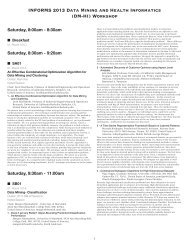
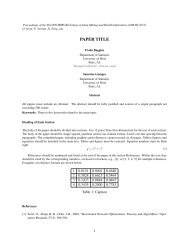
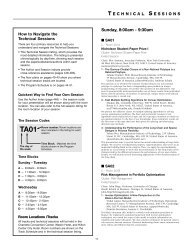
![[PDF] Charlotte Back Matter](https://img.yumpu.com/17933057/1/190x245/pdf-charlotte-back-matter.jpg?quality=85)

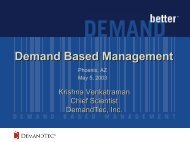
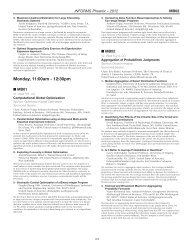

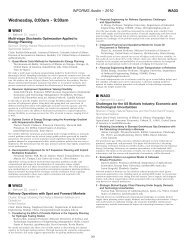
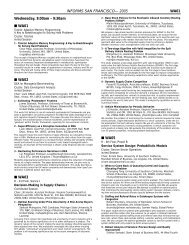
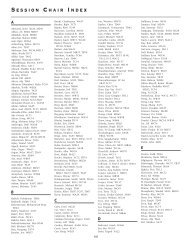
![[PDF] Monday, 8:00am - 9:30am](https://img.yumpu.com/17932954/1/190x245/pdf-monday-800am-930am.jpg?quality=85)
